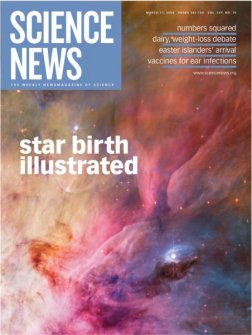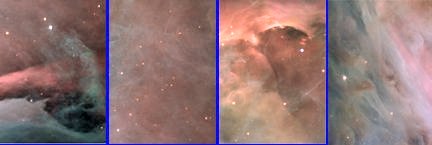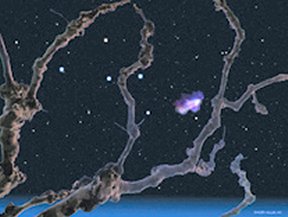Somewhere in the universe, in the dim recesses of a vast cloud of gas and dust, wisps of material are slowly coalescing onto a clump that has been growing for hundreds of thousands of years. Squeezed by gravity, hydrogen atoms deep within the clump suddenly fuse, igniting a fiery glow. A star is born.




Over billions of years, star birth has illuminated countless galaxies and enriched the universe with the elements necessary for life. In the Milky Way, the energy shooting out of young stars pummels surrounding space, creating a tapestry of pillars, arcs, loops, and ripples. Yet for all the drama, scientists’ understanding of star formation remains sketchy. Thick cocoons of gas and dust hide most of the action.
That’s why astronomers have for decades been drawn to the Milky Way’s Orion nebula. This young, star-forming region provides a remarkably clear window on star making. Intense radiation and fierce winds from a quartet of young, massive stars at Orion’s center have blasted away much of the dusty material.
What’s more, at just 1,500 light-years from Earth, Orion is the closest stellar maternity ward where massive stars have cleared the view.
Twelve years ago, soon after astronauts installed corrective optics on the flawed Hubble Space Telescope, the observatory’s Wide Field and Planetary Camera took the first high-resolution images of Orion. It focused on the region’s core (SN: 6/18/94, p. 391), which includes the massive-star quartet, called the Trapezium. Researchers were surprised to learn that many stars at the core, including some of the Trapezium, had the potential to make planets.
Now, a newer and sharper camera on Hubble, the Advanced Camera for Surveys, has recorded the full Orion nebula in detail at wavelengths ranging from the near-infrared to the ultraviolet. The new portrait, a mosaic of 520 razor-sharp Hubble images supplemented by ground-based observations, includes some 3,000 stars packed into a region 13 light-years across. The picture covers 10 times the area of Orion originally imaged by Hubble. About half the stars have never been seen before in visible light, from which astronomers can directly measure illumination from a star’s surface.
The stars span an unusually wide range of sizes, from a few times Jupiter’s mass to 40 times as heavy as the sun. Seeing stars of all sizes so close together provides an extraordinary opportunity to study star formation in all its variety, says Massimo Robberto of the Space Telescope Science Institute in Baltimore. He and his colleagues unveiled the mosaic in January at a meeting of the American Astronomical Society in Washington, D.C.
The portrait also reveals how shock waves, in response to ionizing radiation and winds from the quartet in Orion, sculpt surrounding space into pillars and other shapes. Massive stars not only have a strong influence on their surroundings but also are considered the first type of stars that formed in the universe.
“This is a treasure trove,” comments astronomer Stephen Strom, director of the National Optical Astronomy Observatories in Tucson.
Orion’s bullies
Astronomers are just beginning to sift through the wealth of data in the new Orion portrait. A main goal, says Robberto, is to measure the masses and ages of all the stars in the nebula. That will enable astronomers to map the lifetime of stars, determine how rapidly they’re evolving, and learn whether the 3,000 stars formed episodically or in a single burst. Charting the history of Orion stars might serve as a blueprint for star formation in others parts of the Milky Way and perhaps other galaxies.
Determining a star’s mass and age requires an accurate measurement of its brightness, and in that endeavor the sharpness of the Hubble images is invaluable, notes Robberto. Each star appears as a pinpoint rather than a blob. Researchers can distinguish the light emitted by an individual star from the glow of surrounding gas that’s being heated and sculpted by that star, he says.
The accumulating data indicate that stars in the nebula formed all at once, in a baby boom only about a million years ago, says team member Lynne Hillenbrand of the California Institute of Technology in Pasadena. Astronomers had previously proposed that star birth in Orion was a more sluggish process, spread out over several million years. That scenario was based on less-accurate estimates of stellar brightness in the nebula, Hillenbrand explains.
Another team member, Bob O’Dell of Vanderbilt University in Nashville, led the first Hubble effort to image Orion in 1994. He’s now examining the effect that massive stars at Orion’s core, including the Trapezium, have had on stars at the cloud’s outskirts. These massive stars, the bullies of Orion, produce winds of charged particles a million times as dense as and more energetic than those streaming from the sun.
Images taken at specific wavelengths have enabled astronomers to distinguish the stars from the glow of shock waves generated when strong stellar winds slam into surrounding space. The shock waves erode surrounding gas clouds, and some of the waves may compress free-floating clouds, triggering them to collapse and make new stars.
Hundreds of shock waves travel within Orion. Near the center of the nebula, the shocks race at several hundred kilometers per second, while those in the outer nebula move at only about one-tenth that speed, O’Dell says.
Using the shapes and speed of these disturbances to indicate the waves’ direction, O’Dell finds that a series of shock waves in the outer part of Orion “trace right back into the middle” of the nebula, about 6 light-years away, he told Science News.
The team focused on shocks emanating from two of the star-forming centers in Orion. One region, known as BN-KL, lies about half a light-year behind the Trapezium, as viewed from Earth; the other, Orion South, resides just a few hundredths of a light-year behind the Trapezium.
By tracing the most distant visible shock waves emanating from these regions, O’Dell’s team finds that winds and jets from BN-KL have been pummeling their surroundings for 900 to 1,100 years, while those from Orion South have been blowing for 200 to 1,500 years. These are short periods compared with the million years required for star birth, notes O’Dell. So, winds and jets from newborns appear to blow only intermittently.
Older shock waves may exist but not show up because they’ve moved well beyond the star-forming clusters, where they set the gas aglow, and into more-tenuous parts of the nebula.
Planets in the making
While O’Dell and his colleagues look at Orion as a whole, other astronomers are zooming in on specific regions within the nursery. Several faint red dots identified by Robberto and his team indicate pairs of objects known as brown dwarfs, which glow brightest at near-infrared wavelengths.
Brown dwarfs form as stars do, from the collapse of clouds of gas and dust, but unlike stars, they’re not massive enough to sustain nuclear fusion at their cores.
A few of these low-mass pairs might be so small—less than 13 times the mass of Jupiter—that they wouldn’t even qualify as brown dwarfs. Instead, they would be considered giant planets unattached to a parent star. Astronomers have spied such free floaters in other parts of the galaxy.
Free-floating planets in the high-resolution Orion portrait could shed light on their origins, Robberto says. In the standard planet-formation theory, planets arise exclusively when gas and dust coalesce within disks encircling young stars. In this scenario, free-floating planets once orbited a star but got kicked out of its system, perhaps by the tug of another star.
But a new hypothesis holds that some free floaters never had a parent star. Instead, they arose directly from a star-making cloud of dust and gas.
If mass measurements confirm that some of the red-dot pairs are made up of planets, the standard theory can be put to the test. Robberto and his colleagues plan to determine the velocity of the planets to discern whether they’ve all received a kick. If they haven’t, the researchers say, some of the planets must have come directly from the same clouds that make stars.
Astronomers are using other information from the Hubble images to explore the planet-making potential of Orion’s stars. The researchers are examining the stars surrounded by planet-making disks of gas and dust to predict which will form massive, Jupiterlike planets and which will create smaller, Earth-mass objects. Our solar system might be unusual in having both a Jupiter and smaller planets.
Hubble’s measurements of ultraviolet light (UV) take center stage in the analysis of planet formation, says Strom. UV is produced when material from a disk slams into a star’s surface at speeds of several hundred kilometers per second. Those collisions produce hot spots with temperatures about 10,000 kelvins, almost twice that of the surface of a sunlike star.
The UV intensity from such hot spots reflects how rapidly material is crashing onto the surface of the young star, says Strom. Calculations suggest that those stars with the densest disks produce the brightest ultraviolet emissions. High-density disks are the ones most likely to pack together lots of material rapidly into large, Jupiter-size planets, says Strom. If even a single planet several times heavier than Jupiter forms and migrates inward, its gravity could kick a lower-mass planet out of the system.
Earth-size planets, therefore, probably reside only in low-density disks, which produce only dim UV, Strom notes.
Older or younger
At roughly 1 million years of age, the Orion nebula is a relatively immature star-forming region. While its most massive stars have emerged from their dusty cocoons, many of its lower-mass stars have not yet done so. Robberto and his colleagues have now proposed using Hubble to examine a star-forming region that’s 10 times as old as Orion. They say that comparing an older region with Orion will enable astronomers to trace the process of star birth and planet formation in more detail and over a longer time.
The proposed observation would pose a challenge to Hubble because the orbiting telescope has an extremely narrow field of view. The persistent winds and radiation from massive stars cause the stars of older nurseries to disperse, so a full picture would have to cover a vast area. To take a picture as sharp and complete as the Orion portrait, the observatory would have to spend at least 100 times as much time—its most precious commodity in its last few years of operation—as it required to depict Orion.
Other astronomers have the opposite quest: to compare Orion with a much younger nebula. Researchers announced at the January astronomy meeting that they had identified what may be a future Orion, a gas cloud that has only begun to shine in the constellation Cassiopeia. Shrouds of dust now hide most of the visible light from the nebula, called W3, but the cloud could become the “grand nebula in Cassiopeia,” says Tom Megeath of the Harvard-Smithsonian Center for Astrophysics in Cambridge, Mass.
He and his colleagues speculate that in 100,000 years or so, W3 will be as bright as the Orion nebula is now. Indeed, W3 could come into full bloom just as the Orion nebula begins to fade, says Megeath. The researchers base their findings on infrared and radio wave observations of a clump of budding stars in W3. The team made these long-wavelength images with Hubble’s infrared camera and the Very Large Array radio telescope near Socorro, N.M.
The long wavelengths penetrate the star-forming clump’s thick layers of gas and dust better than visible light does. Astronomers had previously speculated that the cloud contains a single pair of new stars. But Megeath’s team found that it actually holds four or five young, massive stars—like the ones in Orion’s Trapezium but at a much earlier stage of development.
Over the next 100,000 years, says Megeath, these stars may transform W3 in the same way in which the Trapezium stars have altered Orion. Their harsh ultraviolet light and winds will eat away at their dusty surroundings, carving a hole through which visible light can shine.
The notion that W3 could be the next Orion is intriguing, says Hillenbrand, but she cautions that Megeath’s team has examined only the most-massive stars in the region. The researchers can’t be certain whether W3, like Orion, also contains a plethora of lower-mass stars.
Still, such an up-and-coming place, along with the more established Orion, could become “favorite targets for professional astronomers trying to solve the riddle of massive-star formation,” says Megeath.







